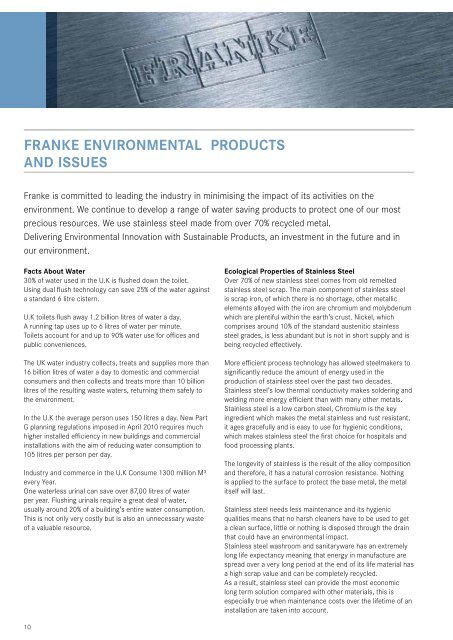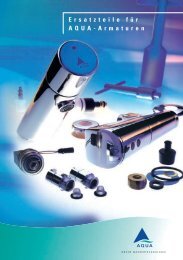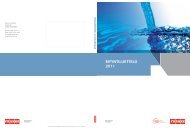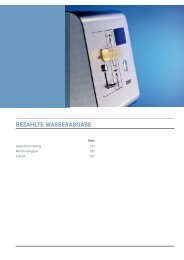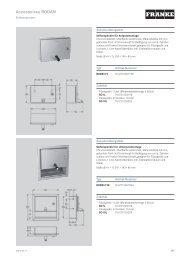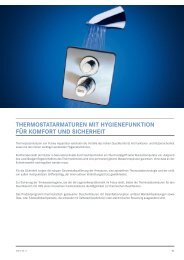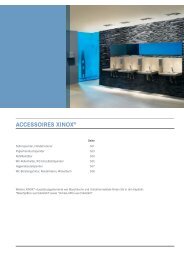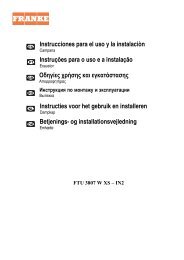Create successful ePaper yourself
Turn your PDF publications into a flip-book with our unique Google optimized e-Paper software.
<strong>FRANKE</strong> ENVIRONMENTAL PRODUCTS<br />
AND ISSUES<br />
Franke is committed to leading the industry in minimising the impact of its activities on the<br />
environment. We continue to develop a range of water saving products to protect one of our most<br />
precious resources. We use stainless steel made from over 70% recycled metal.<br />
Delivering Environmental Innovation with Sustainable Products, an investment in the future and in<br />
our environment.<br />
Facts About Water<br />
30% of water used in the U.K is flushed down the toilet.<br />
Using dual flush technology can save 25% of the water against<br />
a standard 6 litre cistern.<br />
U.K toilets flush away 1.2 billion litres of water a day.<br />
A running tap uses up to 6 litres of water per minute.<br />
Toilets account for and up to 90% water use for offices and<br />
public conveniences.<br />
The UK water industry collects, treats and supplies more than<br />
16 billion litres of water a day to domestic and commercial<br />
consumers and then collects and treats more than 10 billion<br />
litres of the resulting waste waters, returning them safely to<br />
the environment.<br />
In the U.K the average person uses 150 litres a day. New Part<br />
G planning regulations imposed in April 2010 requires much<br />
higher installed efficiency in new buildings and commercial<br />
installations with the aim of reducing water consumption to<br />
105 litres per person per day.<br />
Industry and commerce in the U.K Consume 1300 million M³<br />
every Year.<br />
One waterless urinal can save over 87,00 litres of water<br />
per year. Flushing urinals require a great deal of water,<br />
usually around 20% of a building’s entire water consumption.<br />
This is not only very costly but is also an unnecessary waste<br />
of a valuable resource.<br />
10<br />
Ecological Properties of Stainless Steel<br />
Over 70% of new stainless steel comes from old remelted<br />
stainless steel scrap. The main component of stainless steel<br />
is scrap iron, of which there is no shortage, other metallic<br />
elements alloyed with the iron are chromium and molybdenum<br />
which are plentiful within the earth’s crust. Nickel, which<br />
comprises around 10% of the standard austenitic stainless<br />
steel grades, is less abundant but is not in short supply and is<br />
being recycled effectively.<br />
More efficient process technology has allowed steelmakers to<br />
significantly reduce the amount of energy used in the<br />
production of stainless steel over the past two decades.<br />
Stainless steel’s low thermal conductivity makes soldering and<br />
welding more energy efficient than with many other metals.<br />
Stainless steel is a low carbon steel, Chromium is the key<br />
ingredient which makes the metal stainless and rust resistant,<br />
it ages gracefully and is easy to use for hygienic conditions,<br />
which makes stainless steel the first choice for hospitals and<br />
food processing plants.<br />
The longevity of stainless is the result of the alloy composition<br />
and therefore, it has a natural corrosion resistance. Nothing<br />
is applied to the surface to protect the base metal, the metal<br />
itself will last.<br />
Stainless steel needs less maintenance and its hygienic<br />
qualities means that no harsh cleaners have to be used to get<br />
a clean surface, little or nothing is disposed through the drain<br />
that could have an environmental impact.<br />
Stainless steel washroom and sanitaryware has an extremely<br />
long life expectancy meaning that energy in manufacture are<br />
spread over a very long period at the end of its life material has<br />
a high scrap value and can be completely recycled.<br />
As a result, stainless steel can provide the most economic<br />
long term solution compared with other materials, this is<br />
especially true when maintenance costs over the lifetime of an<br />
installation are taken into account.


